Willkommen, Besucher Nummer seit 1.Jan.2009! © Copyright 1996-2014 by erich.eder@univie.ac.at. Logo (Lepidurus apus) © 2009 by Luise Hofer. Alle Rechte vorbehalten. Gerichtsstand ist Wien. |
Gefährdung und Schutz
2008: Naturschutzpreis für Erich Eder Urzeitkrebse sind in ganz Europa gefährdet. Habitatvernichtung durch Drainage und Zuschüttung sowie Regulierung und Stauhaltung von Flüssen sind die Hauptursachen der Gefährdung. Zum Schutz der Urzeitkrebse ist daher neben dem Flächenschutz die Erhaltung der hydrologischen Dynamik der Lebensräume entscheidend. Die Bedeutung gerade kleiner temporärer Wasserstellen als Lebensraum für gefährdete und wenig bekannte Arten wird oft unterschätzt und auch bei Naturschutzmaßnahmen wenig berücksichtigt. Die "Inland Water Crustacea Spezialist Group" der Species Survival Commission der IUCN befasst sich weltweit mit dem Schutz der Groß-Branchiopoden und empfiehlt nachdrücklich die Erstellung nationaler "Roter Listen" für Urzeitkrebse. |
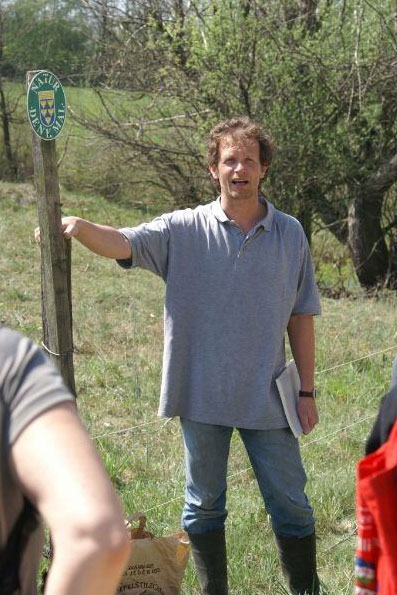 |
Was jeder für den Schutz der Urzeitkrebse machen kann: hier klicken!
Erfolgreiche Schutzprojekte der letzten Jahre:
Die Tümpelwiese am Pulverturm
Auf Grund der Gefährdung der Groß-Branchiopoden wurden in Österreich bereits mehrere Schutzinitiativen gesetzt. Das 1982 auf Antrag von Walter Hödl geschaffene Naturdenkmal "Tümpelwiese beim Marchegger Pulverturm", einziges heimisches Vorkommen von Chirocephalus shadini , war damals das erste Urzeitkrebs-Schutzgebiet der Welt !
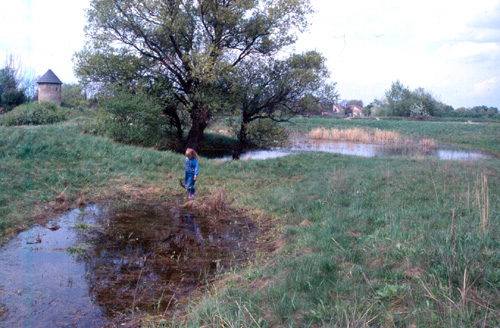
Die Blumengang-Senke
Die öffentliche Aufmerksamkeit beschleunigte den Unterschutzstellungsprozess des artenreichsten Urzeitkrebs-Vorkommens Österreichs: Am 19. Juni 1996 wurde die 7.5 ha große "Blumengang-Senke", Lebensraum von 6 Urzeitkrebs-Arten, darunter Triops cancriformis und alle heimischen Muschelschaler, auf Antrag von Erich Eder zum Naturdenkmal erklärt.

(Die Blumengang-Senke, links trocken, rechts überschwemmt, ist ein Musterbeispiel für den Lebensraum der "Urzeitkrebse".)
Die Triops-Senke
Das größte heimische Vorkommen von Triops cancriformis
steht bis heute nicht unter Schutz. Diese hochinteressante Ackersenke,
die nur unregelmäßig Wasser führt, beherbergt nicht nur die älteste
lebende Tierart der Welt - und das in Massen - sondern insgesamt sechs
Urzeitkrebs-Arten. Je nach Jahreszeit und Temperatur kommen dort der
Feenkrebs Eubranchipus grubii, die höchst seltenen Muschelschaler Cyzicus tetracerus, Imnadia yeyetta und Leptestheria dahalacensis, sowie - und das ist sensationell und kommt in ganz Europa nur an zwei bis drei Standorten vor - gleichzeitig mit dem Sommer-Rückenschaler Triops cancriformis dessen "kleiner Bruder", der Frühjahrs-Rückenschaler Lepidurus apus vor.
Seit 1996 liegt ein Antrag auf Unterschutzstellung der Triops-Senke bei
der Bezirkshauptmannschaft auf - leider kam es bis heute zu keiner
Einigung mit den Eigentümern.
Seit 2008 existiert eine neues Bedrohung: Eine kolportierte
Trassenvariante der Autoschnellstraße S8 führt mitten durch die
Triops-Senke hindurch.
Die Urzeitkrebs-Wiese in Gramatneusiedl
wurde 1997 auf Antrag des NÖ Naturschutzbundes unter Schutz gestellt. Der Eigentümer der Wiese, die Gemeinde Gramatneusiedl, stimmte der Unterschutzstellung zu und finanzierte eine Informationstafel über die dort vorkommenden Arten Triops cancriformis und Branchipus schaefferi.
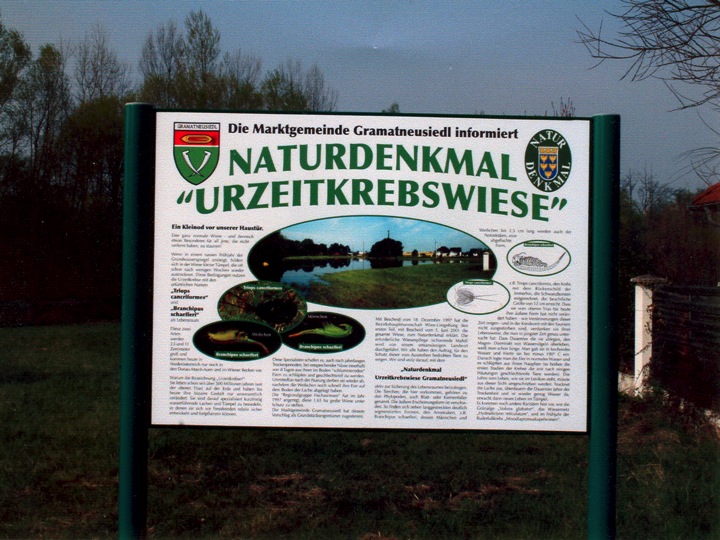
Der alte Marchegger Fußballplatz
Eine Marchegger Hauptschulklasse engagierte sich für den Erhalt des alten Fußballplatzes als Lebensraum für Imnadia yeyetta und Lepidurus apus. Auch in den Medien wurde vielfach über die originellen Urzeit-Tiere auf dem Marchegger Fußballplatz berichtet.
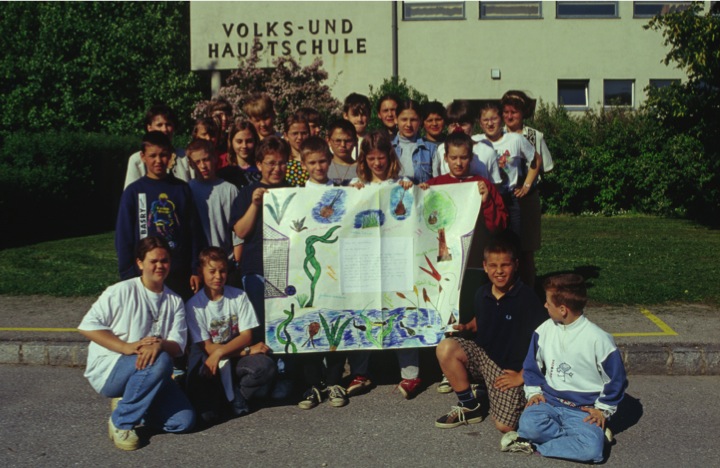
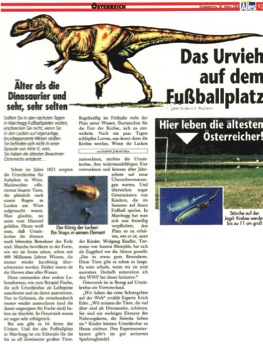
Der Fußballplatz wurde zwar nicht zum Naturdenkmal erklärt,
aber die gemeinde Marchegg verpflichtete sich, den Standort nicht zu
verändern und "urzeitkrebs-konform" zu pflegen.
Welcome, visitor number since Jan.1,2009! © Copyright 1996-2014 by erich.eder@univie.ac.at. Logo (Lepidurus apus) © 2009 by Luise Hofer. All rights reserved, legal venue is Vienna. |
Threats and conservation
2008 : Nature conservation award for Erich Eder Large branchiopods are endangered throughout Europe. Habitat degradation by drainage and filling up as well as regulation of rivers and hydroelectric power plants are to be considered as the main threats. Therefore, conservation of habitats and their hydrologic dynamics are the essential measures to protect large branchiopods. The importance of small temporary water bodies as a habitat for endangered and poorly known species is often underestimated and even neglected within conservational activities. The "Inland Water Crustacea Spezialist Group" of the IUCN Species Survival Commission der IUCN has evaluated the world wider threats to large branchiopods and asked for national "Red Lists" for this group to be able to initiate effective international conservational programs. |
 |
What can YOU do to help the primeval shrimps? Click here!
Recent conservation success:
The "Tümpelwiese" site
In Austria, several conservational measures for threatened large branchiopod species have been initiated. In 1982, the nature reserve "Tümpelwiese beim Marchegger Pulverturm" was declared thanks to the initiative of Walter Hödl, University of Vienna. The only Austrian occurrence of Chirocephalus shadini is the first protected are for large branchiopods world wide!

Decision of the provincial government
The "Blumengang" site
Public awareness caused the accelerated legal procedure regarding the protection of the most diverse Austrian large branchiopod site: on June 19, 1996, the 7.5 ha "Blumengang" site, habitat of six large branchiopod species, among them the tadpole shrimp Triops cancriformis and all clam shrimp species known from Austria, was declared a nature reserve due to the initiative of Erich Eder, University of Vienna.

(The Blumengang site, dry and inundated, is a typical example for large branchiopod habitats.)
Decision of the provincial government
The Triops depression
The biggest Austrian occurrence of Triops cancriformis
is not protected yet. This interesting site within wheat and maize
fields is irregularily flooded by the Morava river. If inundated, it
hosts myriads of the oldest living animal species, plus up to five
additional large branchiopod species. Depending on season and
temperature, the fairy shrimp Eubranchipus grubii, the rare clam shrimps Cyzicus tetracerus, Imnadia yeyetta, Leptestheria dahalacensis occur, and - which is exceptional and only known from two other sites in Europe - simultaneously with the summer tadpole shrimp Triops cancriformis its "little brother", the spring tadpole shrimp Lepidurus apus.
Since 1996, we try to protect the Triops depression - but no agreement with the land owners could be made so far.
Since 2008, an additional threat to this habitat is looming: the
highway S8 between Vienna and Bratislava could possibly go right
through the Triops depression.
The Primeval Shrimp Meadow in Gramatneusiedl
was protected 1997 due to the initiative of the NÖ Naturschutzbund. The owner of the meadow, the community of Gramatneusiedl, agreed with the protection and financed an information panel about the two occuring species Triops cancriformis and Branchipus schaefferi.

Decision of the provincial government
Der alte Marchegger Fußballplatz
A middle school class in Marchegg got involved with the protection of the old football field as a habitat for Imnadia yeyetta and Lepidurus apus. Austrian media reported several times about the original primeval animals on the soccer field...


Finally, the football field was not declared a nature reserve, but
the community of Marchegg committed itself to keep the site unchanged
and suitable for large branchiopods.
Bienvenido visitante numero desde Enero 1 de 2009 © Copyright 1996-2014 by erich.eder@univie.ac.at. Logo (Lepidurus apus) © 2009 by Luise Hofer. All rights reserved, legal venue is Vienna. |
Peligro y protección
2008: Nature conservation award for Erich Eder Large branchiopods are endangered throughout Europe. Habitat degradation by drainage and filling up as well as regulation of rivers and hydroelectric power plants are to be considered as the main threats. Therefore, conservation of habitats and their hydrologic dynamics are the essential measures to protect large branchiopods. The importance of small temporary water bodies as a habitat for endangered and poorly known species is often underestimated and even neglected within conservational activities. The "Inland Water Crustacea Spezialist Group" of the IUCN Species Survival Commission der IUCN has evaluated the world wider threats to large branchiopods and asked for national "Red Lists" for this group to be able to initiate effective international conservational programs. |
 |
Lo que Vd. puede hacer para ayudar a los cangrejos antediluvianos: oprime aqui !
Recent conservation success:
The "Tümpelwiese" site
In Austria, several conservational measures for threatened large branchiopod species have been initiated. In 1982, the nature reserve "Tümpelwiese beim Marchegger Pulverturm" was declared thanks to the initiative of Walter Hödl, University of Vienna. The only Austrian occurrence of Chirocephalus shadini is the first protected are for large branchiopods world wide!

Decision of the provincial government
The "Blumengang" site
Public awareness caused the accelerated legal procedure regarding the protection of the most diverse Austrian large branchiopod site: on June 19, 1996, the 7.5 ha "Blumengang" site, habitat of six large branchiopod species, among them the tadpole shrimp Triops cancriformis and all clam shrimp species known from Austria, was declared a nature reserve due to the initiative of Erich Eder, University of Vienna.

(The Blumengang site, dry and inundated, is a typical example for large branchiopod habitats.)
Decision of the provincial government
The Triops depression
The biggest Austrian occurrence of Triops cancriformis
is not protected yet. This interesting site within wheat and maize
fields is irregularily flooded by the Morava river. If inundated, it
hosts myriads of the oldest living animal species, plus up to five
additional large branchiopod species. Depending on season and
temperature, the fairy shrimp Eubranchipus grubii, the rare clam shrimps Cyzicus tetracerus, Imnadia yeyetta, Leptestheria dahalacensis occur, and - which is exceptional and only known from two other sites in Europe - simultaneously with the summer tadpole shrimp Triops cancriformis its "little brother", the spring tadpole shrimp Lepidurus apus.
Since 1996, we try to protect the Triops depression - but no agreement with the land owners could be made so far.
Since 2008, an additional threat to this habitat is looming: the
highway S8 between Vienna and Bratislava could possibly go right
through the Triops depression.
The Primeval Shrimp Meadow in Gramatneusiedl
was protected 1997 due to the initiative of the NÖ Naturschutzbund. The owner of the meadow, the community of Gramatneusiedl, agreed with the protection and financed an information panel about the two occuring species Triops cancriformis and Branchipus schaefferi.

Decision of the provincial government
Der alte Marchegger Fußballplatz
A middle school class in Marchegg got involved with the protection of the old football field as a habitat for Imnadia yeyetta and Lepidurus apus. Austrian media reported several times about the original primeval animals on the soccer field...


Finally, the football field was not declared a nature reserve,
but the community of Marchegg committed itself to keep the site
unchanged and suitable for large branchiopods.
